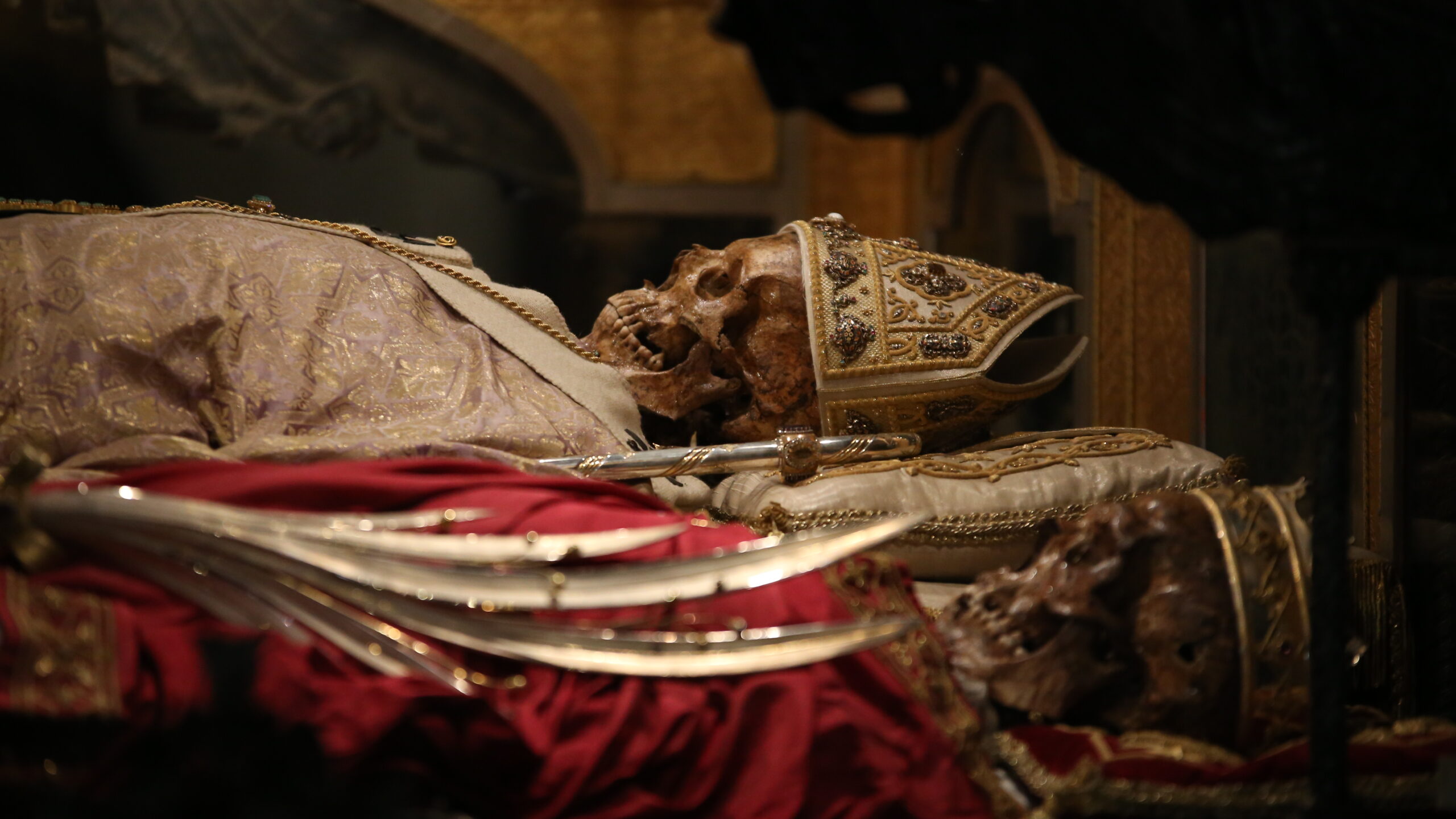I write these words from Milan, Italy, where I am with my Word on Fire team filming new episodes for our Pivotal Players series. I’ve seen lots of marvelous things on this trip, including the ruins of the ancient baptistery under the Milan Cathedral where, in the spring of 387, St. Augustine was baptized by St. Ambrose. But the most fascinating sight I’ve taken in is the vested and mitered skeleton of that same Ambrose, which rests in the basilica that bears his name, not far from the Cathedral.
Behind a grille, just under the main altar, lie the skeletal remains of Ambrose and two martyr saints, Gervasius and Protasius, whose bodies were recovered during his lifetime. With the aid of some pretty high-powered camera lenses, I was able to see the skull of the great bishop of Milan in extraordinary detail. What struck me especially was the size and solidity of his teeth, still formidable after 1,600 years. I’ll confess that when I examined those ancient teeth, I couldn’t help but think of the lips that once covered them, for Augustine, in his Confessions, famously reported his amazement at seeing Ambrose read without moving his lips—something quite unusual at the time.
However, after I posted detailed photos of Ambrose’s skull on our Facebook page, the reaction has been rather…interesting. Many, many people expressed their pleasure and excitement at seeing the pictures, but many others, I must say, were a bit put off. From a number of strongly Protestant and evangelical commentators came the charge that I was encouraging the worship of dead bodies! Well, that’s just silly. This has, of course, nothing to do with worshipping Ambrose but rather honoring him. But most of those, both Protestant and Catholic, who had objections to the pictures said something along these lines: “Well, it’s just kind of creepy, isn’t it?” and “Why don’t they just bury the poor man?” or “Isn’t this frightening to children?” Regarding that last question, I can testify that, when I was visiting Ambrose’s sarcophagus, a gaggle of little kids was looking through the grille with rapt attention. They seemed far more fascinated than frightened.
But I want to respond to these more serious concerns, for they allow me to throw light on some pretty basic issues in Catholic theology and spirituality. I might begin with John Henry Newman. When Newman was a young man, he made a pilgrimage to Italy with a couple of likeminded friends. He took in many elements of Catholic life that deeply appealed to him, for they were redolent of the ancient Church that Newman loved. However, other practices, which seemed more superstitious and redolent of folk religion, repelled him. Among these were what he took to be the worship of Mary and the saints and, particularly, the devotion to relics. A purified and Biblical Christianity, he felt, must be rid of such things.
However, some years later, when Newman had made the transition to Catholicism, he saw these practices in an entirely new light. He had come to appreciate, first, that the veneration of relics and the bodies of the saints was an ancient custom in the Christian community. How often, he said, we hear stories of believers placing napkins and cloths at the feet of martyrs to catch some of their blood, or of the reverence paid to the bones of the heroic dead in the catacombs, or of relics of saints working miracles. Secondly, and more importantly, he had come to understand such pious gestures as a logical development of the doctrine of the Incarnation. In Jesus Christ, the Word of God truly became flesh. The Second Person of the Blessed Trinity took to himself a human mind and will and imagination, but also feet, hands, internal organs, muscles, veins, and bones. He lived, died, and rose in a real human body. Subsequently, in the mystical body of the Church, the Incarnation is extended through space and time, the Spirit of Jesus coming to dwell in the humanity of all the baptized and in a privileged way in the humanity of the saints. Paul acknowledged this truth when he cried exultantly, “It is no longer I who live but Christ who lives in me.” How wonderful, too, that this Christ-life is placed in the bodies of the faithful through the materiality of the sacraments: water, oil, imposed hands, transfigured bread and wine, etc. And this, Newman realized, is why the Church has, from the beginning, reverenced the bodies of the saints and treasured their relics. She has known that, as Paul put it, our bodies become temples of the Holy Spirit, dwelling places of Christ.
And thus, we clothe the skeleton of St. Ambrose in stately liturgical robes and we crown his skull with a bishop’s miter, not to be macabre or “creepy,” but because we reverence his body as a place where Christ had come to dwell. One of the oldest and most enduring heresies is Gnosticism, and perhaps the principal mark of this ancient distortion of Christianity is a suspicion of the body. For the Gnostics, the creator God is a fallen, compromised deity, and the whole purpose of the religious life is to escape from grubby matter. Authentic Christianity has always stood against such dualistic nonsense—and one sign of that resistance is the unapologetic showing of the impressive teeth of St. Ambrose!
